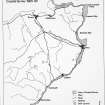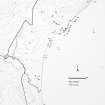Castle Linglas
Broch (Iron Age)(Possible), Long Cist(S) (Early Medieval)
Site Name Castle Linglas
Classification Broch (Iron Age)(Possible), Long Cist(S) (Early Medieval)
Alternative Name(s) Wester Broch, Wic 120; Birkle Hills
Canmore ID 9130
Site Number ND35NW 4
NGR ND 3385 5831
Datum OSGB36 - NGR
Permalink http://canmore.org.uk/site/9130
- Council Highland
- Parish Wick
- Former Region Highland
- Former District Caithness
- Former County Caithness
ND35NW 4 3385 5831
(ND 3385 5831) Castle Linglas (NAT)
Broch (NR) (remains of) (NAT)
Long Cists found (NAT)
OS 1:10,000 map, (1974)
Wester Broch or Castle Linglas is the southern of the two sandhills known locally as the Birkle Hill, and excavated by Sir Francis Tress Barry. The walls of the broch is 13ft thick and encloses an area 27ft in diameter. At 30 to 40ft from the exterior are the remains of an enclosing wall between which and the broch, on the landward side, are the foundations of eight or nine small cells or buildings. The following finds were donated to the National Museum of Antiquities of Scotland (NMAS) in 1908: Three rounded quartzite painted pebbles; various bone implements; stone discs; whorls; pebbles and implements; horn handles. Also found but seemingly not donated were an upper quern stone, a saddle quern, and fragments of very coarse pottery.
Over the top of the wall of the broch, and in the sand which covered it, were four extended burials in cists. The bones of a child were found in one of the outbuildings.
J Anderson 1901; Proc Soc Antiq Scot 1909; RCAHMS 1911.
The remains of this broch are situated in sand dunes which have encroached on all sides except the W, the broch lying at the foot of the dunes. Little of it is visible, but the internal diamter of the broch appears to have been 8.8m. Traces of the outer face of the wall are visible on only the W segment, giving the broch an overall diameter of 18.0m. Where exposed, the inner and outer faces of the wall have maximum heights of 0.5 and 0.3m respectively. The level of the interior is 1.2m maximum depth below the crest of the broch, but is mainly silted up as is the entrance, which has been on the W side. There is no trace of the outer wall, buildings or cists, which have presumably been covered by the drifting sound.
Revised at 1:2500.
Visited by OS (R D L) 23 April 1963.
Mostly sand-covered rubble, nothing being clearly visible except the outline of a curving wall. The area in the immediate vicinity has been excavated by Kestrel Marine.
C E Batey 1981.
The remains of Castle Linglas broch are as described by the previous field investigator.
Visited by OS (N K B) 2 September 1982.
Photographs in Inverness Museum Skull no.1 Found in Wester Broch, 1890 N/N 977.P79.22 Skull no.1 South Birkle Hill, 1890,Wester Broch N/N 977.P79.23
(Undated) information in NMRS.
ND 3385 5831 Damage caused by a digger running over this scheduled monument was repaired. No significant damage is considered to have occurred to the monument.
Sponsor: Historic Scotland
J Wordsworth 1997
Project (1980 - 1982)
Field Visit (1981)
Mostly sand-covered rubble, nothing being clearly visible except the outline of a curving wall. The area in the immediate vicinity has been excavated by Kestrel Marine.
C E Batey 1981.
Publication Account (2007)
ND35 8 WESTER BROCH ('Castle Linglas')
ND/3385 5831
This probable solid-based broch in Wick, Caithness, stands among sandhills near the shore. It was excavated by Sir F Tress Barry in 1894 and stands on low ground "just within the fringe of sandhills which border the shore" [3]. There is very little to be seen now except the outline of a curving wall [7]. The information about the site therefore comes entirely from the excavator, by way of Joseph Anderson and a plan and a photograph [2, 4].
Description
The main entrance is on the west-north-west and was 3.97m (13ft) long, 1.07m (3.5ft) wide at the exterior and 79cm (2ft 7in) at the inner end. The door-frame is 2.75m (9ft) in but the design of the checks is not described (see below). At 9 o'clock is the doorway to the mural stair which is raised 92cm (3ft) above the interior floor; it is 76cm (2ft 6in) wide. There was a stair-foot guard cell 2.90m (9ft 6in) long and 92cm (3ft) wide but this had become invisible again in 1910 [3]. The photograph shows the partially cleared interior and the inner end of the entrance passage with the two slab-checks of the door-frame close to the inner end.
The broch is surrounded by traces of outbuildings but – as with many another 'excavated' Caithness broch – the plan of their walls is incoherent and they were evidently not explored systematically. Around these on the north-west and south-west runs a wall which may have surrounded the whole complex. It is impossible to tell from the plan and description whether it was an outer defence or simply a boundary wall for the presumably secondary settlement around the tower.
Finds:
Bone and antler: 1 needle (no. 23) and (also described as a needle) a fish gorge (no. 24), 2 pins or awls, 1 pin with a globular head, 2 more pins (broken), 1 plain long-handled comb (no. 21), 3 antler rings, 1 femur-head whorl or button (no. 25) and 1 possible bridle cheek-piece – a “curved bone” 10cm (4in) long with an oval hole (no. 22).
Stone tools included 4 roughly chipped discs or pot-lids, 2 whetstones, 1 decorat-ed whorl ornamented with 15 drilled pits and half a plain whorl (no. 28).
Some pottery is also included with the finds in the National Museums (nos. 26 and 27) and it includes 2 rim sherds which in form resemble the late Bronze Age ‘Dunagoil vases’ from Crosskirk – particularly no. 27 with the indentations under the slightly out-turned rim – but which are made of a hard-fired, smooth, grey ware.
Joseph Anderson also mentions the following objects which do not seem to have reached the National Museum [2]: 1 upper stone of a rotary quern, several saddle querns, and 3 quartzite pebbles with painted spots [2, fig. 22]. One of the querns is the standard Atlantic, disc-shaped type with a loose handle-hole in the upper surface; the one on the left of the photograph appears to be a lower stone of the same type.
Dimensions: external diameter c. 16.47m (54ft), internal 8.24m (27ft); the wall proportion is about 50%.
Sources: 1. NMRS site no. ND 35 NW 4: 2. Anderson 1901, 119-22: 3. Proc Soc Antiq Scot 43 (1908-9), 119 (finds): 4. RCAHMS 1911b, 153-4, no. 513, and fig. 58: 5. Young 1962, 184: 6. Caulfield 1978, 132, no. 19: 7. Swanson (ms) 1985, 604-05: 8. Batey 2002, 187: 9. J Wordsworth in Discovery and Excavation Scotland 1997, 52.
E W MacKie 2007




































































